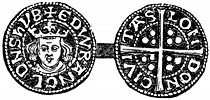 The Lombards and other Italian merchants first introduced the term bank in the commercial centers of medieval western Europe to signify the business of money. Banks – the term means “credit negotiated on a counter at banco” — grew in the Middle Ages as a result of a wider money economy during the 11th and 12th centuries. The frequency in transactions fueled the growth of banks, and early banks built up their capital by applying hidden interest to deposits. Usury, or interest charged on loans, also increased the banks’ profits. The church condemned the act of ursury, but bankers still collected their interest by disguising it in exchange rates. They also openly justified their rights to charge interest by claiming they risked loss during their transactions. While condemned by ecclesiastical law, the church — including the Pope — still participated in usurious transactions and used Italian companies to help develop its taxation system. The church routinely accused Jews of exploiting the system and overcharging on interest.
The Lombards and other Italian merchants first introduced the term bank in the commercial centers of medieval western Europe to signify the business of money. Banks – the term means “credit negotiated on a counter at banco” — grew in the Middle Ages as a result of a wider money economy during the 11th and 12th centuries. The frequency in transactions fueled the growth of banks, and early banks built up their capital by applying hidden interest to deposits. Usury, or interest charged on loans, also increased the banks’ profits. The church condemned the act of ursury, but bankers still collected their interest by disguising it in exchange rates. They also openly justified their rights to charge interest by claiming they risked loss during their transactions. While condemned by ecclesiastical law, the church — including the Pope — still participated in usurious transactions and used Italian companies to help develop its taxation system. The church routinely accused Jews of exploiting the system and overcharging on interest.
In medieval western Europe and Italy during the 13th century, merchants began to invest in lending money more and more. They affected financial transactions and the forms of money available in the European economy. These merchants moved coins and possessions for kings and lords who traveled to and from the Middle East on the Crusades. Temporary companies granted temporary letters of credit, and these letters of credit passed among bankers, agents, and representatives. This system was especially useful for those traveling long distances, such as to the fairs of Champagne. The large banks that grew up out of the transactions of the 11th, 12th, and 13th centuries saw a collapse after numerous bankruptcies around the turn of the 14th century. Smaller banks replaced these larger banks for a while, but the larger banks did see a resurgence near the end of the 15th century by financing large-scale ventures of kings, powerful lords, and popes.
Sources:
English, Edward D. “banking during the Middle Ages.” Encyclopedia of the Medieval World, vol. 1. New York: Facts On File, Inc., 2005. Ancient and Medieval History Online. Facts On File, Inc. http://www.fofweb.com/activelink2.asp?
ItemID=WE49&iPin=EMW0163&SingleRecord=True (accessed December 10, 2008).
“Penny of Edward I.” From: Charles Knight. Old England: A Pictorial Museum of Regal, Ecclesiastical, Baronial, Municipal and Popular Antiquities. London: Charles Knight and Co., 1845. Ancient and Medieval History Online. Facts On File, Inc. http://www.fofweb.com/activelink2.asp?
ItemID=WE49&iPin=AMH287&SingleRecord=True (accessed December 10, 2008).
Additional Reading:
Center for Medieval and Renaissance Studies, University of California, Los Angeles, The Dawn of Modern Banking (New Haven, Conn.: Yale University Press, 1979); Carlo M. Cipolla, Before the Industrial Revolution: European Society and Economy, 1000-1700, 3d ed. (New York: Norton, 1993); Frederic C. Lane and Reinhold Mueller, Money and Banking in Medieval and Renaissance Venice: Coins and Moneys of Account (Baltimore: Johns Hopkins University Press, 1985); Robert S. Lopez and Irving W. Raymond, eds., Medieval Trade in the Mediterranean World: Illustrative Documents with Introductions and Notes (New York: Columbia University Press, 1955); Robert S. Lopez, The Commercial Revolution of the Middle Ages, 950-1350 (Englewood Cliffs, N.J.: Prentice-Hall, 1971); Léon Poliakov, Jewish Bankers and the Holy See from the Thirteenth to the Seventeenth Century, trans. Miriam Kochan (London: Routledge and K. Paul, 1977); Nabil A. Saleh, Unlawful Gain and Legitimate Profit in Islamic Law: Riba, Gharar, and Islamic Banking (Cambridge: Cambridge University Press, 1986).
When a medieval banker was unable to continue trading due to lack of funds his trading bench was broken – or “banco rotta”.
From these two words we get the term “bankrupt”
Elaine Saunders
Author – A Book About Pub Names
http://www.completetext.com
Very interesting. I did not know that. Thanks for sharing, Elaine.